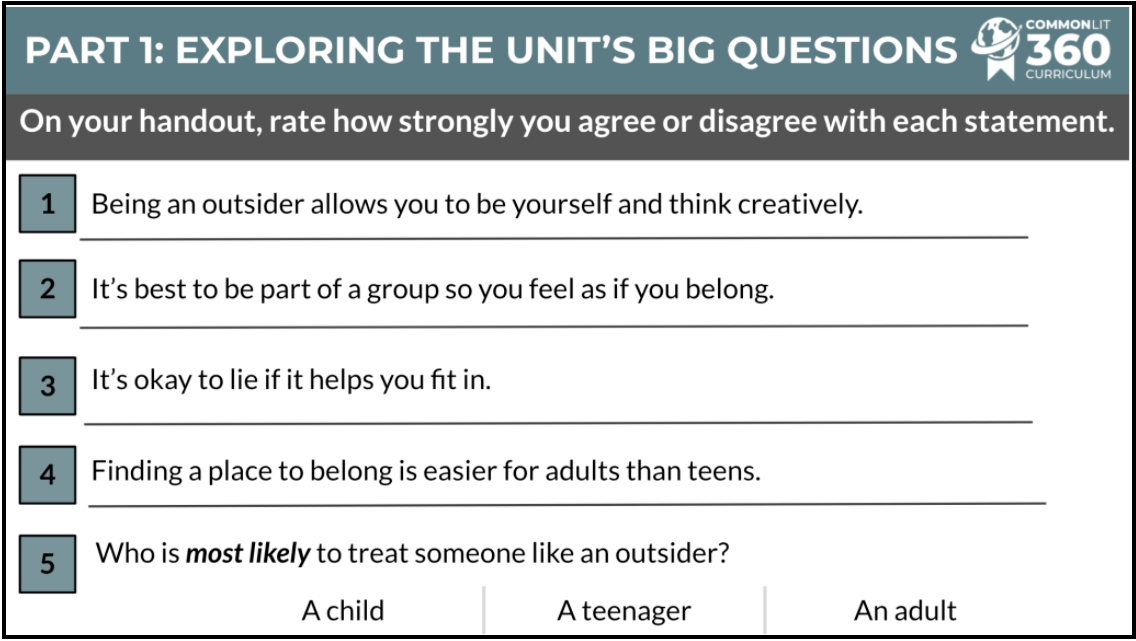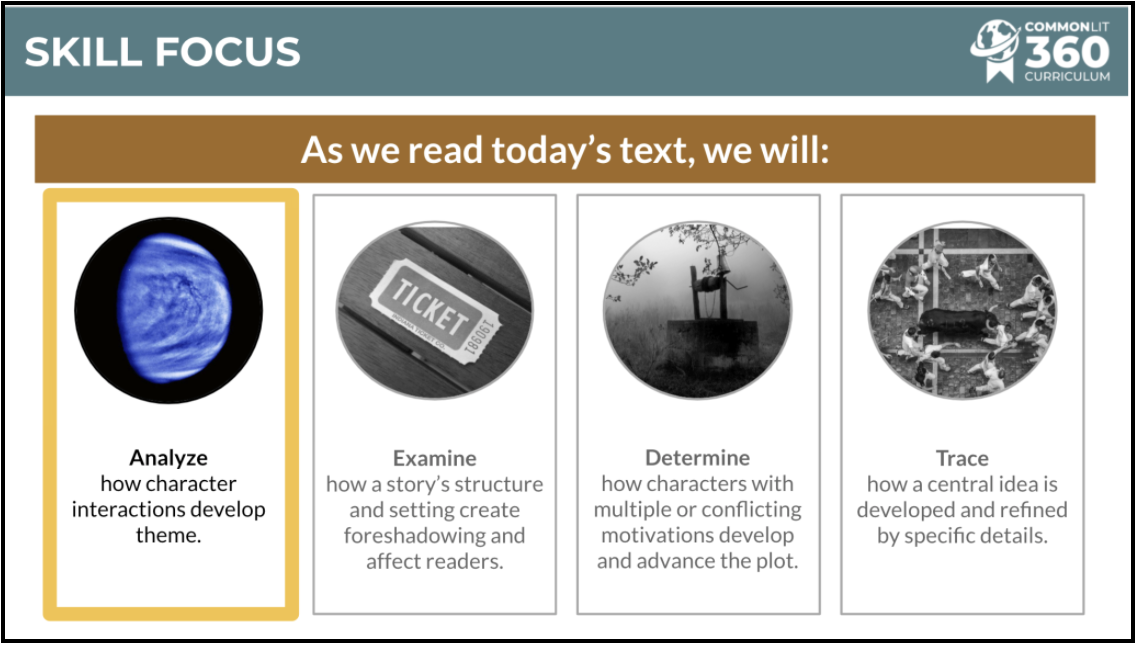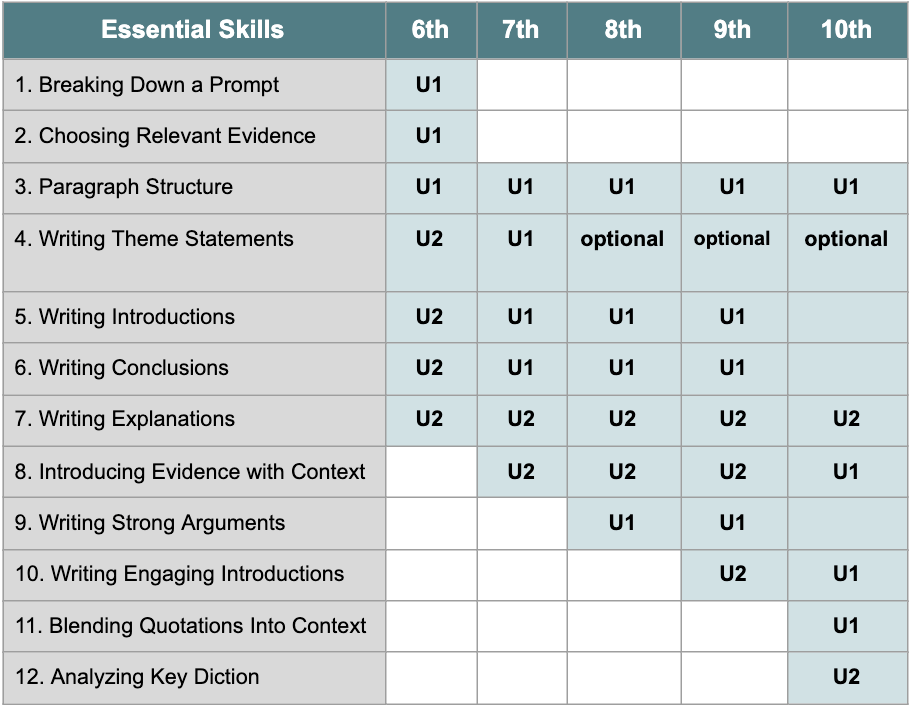 CommonLit 360
Everything You Need to Know About Unit 1 in CommonLit 360 for Grades 6-10
CommonLit 360
Everything You Need to Know About Unit 1 in CommonLit 360 for Grades 6-10
Unit 1s begin the year with engaging short stories with lessons that build literary analysis skills and promote student voice.
The first unit of the year in any ELA class sets the tone for the rest of the school year. This is your chance to establish a safe and collaborative classroom environment, communicate your expectations for quality work, and lay the foundation for the reading, writing, and discussion routines that will happen throughout the school year.
In this post, I’ll explain how CommonLit 360 Unit 1s do just this across grades 6–10. Note: If you haven’t already learned about this full-year comprehensive ELA curriculum for grades 6–10, I recommend starting with this introductory blog post or exploring the units for your grade here.
Now, let’s take a look at what makes the first unit of CommonLit 360’s curriculum unique for all grade levels and how it sets students up for a successful school year!
Engaging Students Through Essential Questions
At the beginning of a school year, engagement is a top of mind! Teachers spend a lot of time thinking about how to build authentic student engagement, by learning about individual students, establishing a safe classroom environment, and inviting students to participate in class discussions. Across the CommonLit 360 Curriculum, Unit 1 topics are designed to be high interest, and are grounded in adolescent interests and concerns. At each grade level, Unit 1 topics are anchored in the questions, thoughts, and emotions that students at that age are already naturally grappling with.

Here are the topics and essential questions for unit one, grades 6–10:
- Grade 6: Characters Who Change and Grow — How are people changed through their relationships and experiences?
- Grade 7: In or Out: Our Struggle to Belong — What does it mean to be an outsider? How does our need to belong affect our actions?
- Grade 8: Bad Behavior — How do we know what is right? Why do people choose to do wrong?
- Grade 9: Following the Crowd — How does being in a group affect how we behave?
- Grade 10: Coming of Age — What experiences lead us from childhood to adulthood?
When it comes to student engagement, a great topic and an engaging text is a very strong foundation. Next, it’s time to encourage student voice and participation. Within CommonLit 360, Unit introductory exercises are designed to immediately get students interested in the topic. These activities prompt students to connect the unit’s topic to their own lives and then participate in a class discussion. On the first day, you’re setting the tone that your students have ideas worth sharing.

A Focus on Knowledge, Skills, and Genre
Across Unit 1s of the CommonLit 360 curriculum, short stories take center stage. Each Unit 1 consists of 3–5 short stories and 1–2 nonfiction texts to build knowledge, skills, and a deep understanding of the conventions of the short story genre. Since these texts are relatively short, this genre provides a perfect entry point to establish new academic routines in ELA class, giving students multiple opportunities to practice throughout the 5–7 week unit. These approachable short stories are perfect for having students close reading, deeper textual analysis, and cross-textual synthesis. The routines kids learn in Unit 1 will help them gain the confidence and skills necessary to tackle full-length novels, independent research, and more in subsequent units.

Building Foundational Writing Skills
Writing is an important domain of English Language Arts, and also arguably the hardest skill to teach and the hardest skill to master. As you can see in the graphic below, writing lessons that happen within the first two units across the CommonLit 360 Curriculum are focused on reinforcing the foundational building blocks of academic writing. In Unit 1s, direct instruction in writing first reinforces the expectations for writing complete and coherent paragraphs before shifting to planning and drafting full-length essays. While these units address the same skills across grade levels, student output becomes more robust and sophisticated as the grades progress, keeping with grade-level expectations. Within CommonLit 360, students are also exposed to lots of model writing. In Unit 1, these exemplar paragraphs set the expectations for student writing. Over time, they increase in sophistication and fluency, showing students how to embed evidence and explanations with a greater command of language, sentence variation, and polish.

Another way that CommonLit 360 sets expectations for the year is through a culminating writing assignment. So, if students receive the full year of CommonLit 360 curriculum, they will build portfolios of a wide variety of argumentative, informative, and narrative writing and will be able to reflect upon their writing growth over that year.
Don’t Forget
Of course, these units still have all the features that make CommonLit 360 curriculum so great: robust vocabulary learning activities, engaging related media lessons, digitally assignable reading and writing lessons, and supplemental texts for flexible use.
Next Steps
If you are interested in learning more about how vocabulary and other integral language arts skills are addressed within the brand new CommonLit 360 units, here are some recommended next steps:
- Browse the 360 Curriculum here.
- Sign up for a CommonLit 360 webinar for an opportunity to learn more and ask questions.
- Learn about the affordable wraparound services for schools and districts looking to adopt CommonLit 360.

